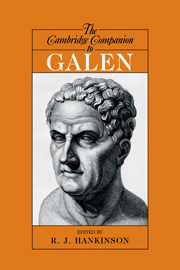Book contents
- Frontmatter
- 1 The man and his work
- 2 Galen and his contemporaries
- 3 Methodology
- 4 Logic
- 5 Language
- 6 Epistemology
- 7 Psychology
- 8 Philosophy of nature
- 9 Anatomy
- 10 Physiology
- 11 Therapeutics
- 12 Drugs and pharmacology
- 13 Commentary
- 14 The fortunes of Galen
- Appendix 1: A guide to the editions and abbreviations of the Galenic corpus
- Appendix 2: English titles and modern translations
- Bibliography
- Index
10 - Physiology
Published online by Cambridge University Press: 28 September 2008
- Frontmatter
- 1 The man and his work
- 2 Galen and his contemporaries
- 3 Methodology
- 4 Logic
- 5 Language
- 6 Epistemology
- 7 Psychology
- 8 Philosophy of nature
- 9 Anatomy
- 10 Physiology
- 11 Therapeutics
- 12 Drugs and pharmacology
- 13 Commentary
- 14 The fortunes of Galen
- Appendix 1: A guide to the editions and abbreviations of the Galenic corpus
- Appendix 2: English titles and modern translations
- Bibliography
- Index
Summary
The study of the principal functions of living things, such as respiration, nutrition, reproduction, perception and so on, was a major preoccupation of many Greek philosophers, from Democritus, Empedocles and Plato to the fundamental contribution made by Aristotle in his biological works. Alexandrian medicine played its part, too, both by considerably deepening anatomical understanding and by developing new types of explanation. In addition to Herophilus' groundbreaking discoveries in anatomy, in particular those concerning the brain and the nervous system, Erasistratus had also developed general physiological principles, and Galen acknowledges his debts in this regard in numerous contexts. Nor did these researches come to an end after the Hellenistic period. During his medical training at Pergamum, and afterwards at Smyrna and Alexandria, Galen was taught by some remarkable anatomists, for whom the study of anatomy was always closely bound up with that of physiology. This tradition, in turn, was linked to the authority of Hippocrates, in whom Galen is sure that he finds a highly sophisticated anatomical understanding (he wrote a treatise on Hippocrates' anatomy), as well as a physiology which is founded upon principles which are also supposedly his own. For what Galen learns also from his masters is ’the demonstration and proof’ of facts and their explanations by way of reasoning and anatomical demonstration, which in turn entails a systematic recourse to the dissection of dead animals as well as to the vivisection of living ones. Indeed, vivisection is in his view the most appropriate method for discovering animal functions.
- Type
- Chapter
- Information
- The Cambridge Companion to Galen , pp. 263 - 282Publisher: Cambridge University PressPrint publication year: 2008
- 16
- Cited by

